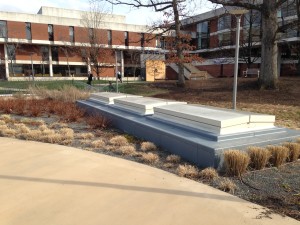This semester, our team will be studying the night flight calls of birds as observed across the UVA campus. Despite their great intrigue and potentially impactful meaning, night flight calls are a topic yet to be well understood even by experts in the field. As a result, some background is necessary before delving into research.
Bird night flight calls (NFCs) are not the bird song or chirping that to which we are accustomed; not mellifluous like normal, these calls are instead usually short, low buzzes or whispers, lasting a maximum of just half a second. Though their short, monotonous nature may suggest otherwise, night flight calls are a complex language – each species features its own unique method of calling, be that in tone, length, or pattern of calls. Most often heard during migrations (hence their occurrences at night), it is speculated that these calls, at a fundamental level, are bird communication, helping birds remain in flock, keep formation, and warn others of potential collision or danger. Current professional research in the subject seeks to analyze NFCs to understand how birds navigate through cities, the way in which various bird species respond to the stress of urban areas (primarily, whether birds stop or not), and what measures can be taken to make cities more bird-friendly.
Our primary research goal will be analyzing the frequency and abundance of NFCs heard around UVA grounds. Albemarle County is on the migratory flight path of a number of bird species, and UVA has been cited as a prime spot to observe bird migration; the Monticello Bird Club has documented almost 24 different species of warblers that migrate over the O’Hill area, as well as various species of tanagers, orioles, and other forest birds. Moreover, birds over grounds are most active during spring migration (April 15 to May 15), which coincides nicely with our time of research. A brief analysis of migratory time tables of birds in Charlottesville cross referenced with a list of species found at UVA shows that our analysis will certainly take place within time range of Palm Warbler migration, and potentially within the time range of Bay-Breasted, Blackburnian, and Cerulean Warbler migrations. As a result, we should not only be able to observe great diversity in the NFCs heard, but more importantly hear enough NFCs to draw conclusions about NFC frequency and abundance.
Post by Aaron Weinstock
General background information from: “Nocturnal Migrant Flight Call Research,” by the Bioacoustics Research Lab at the Cornell Lab of Ornithology, found at http://www.birds.cornell.edu/brp/research/nocturnal-migrant-flight-call-research; “Listening to Migratory Birds at Night May Help Ensure Their Safety” by T. Edward Hickens, from the National Audubon Society’s “Audubon Magazine” Sept-Oct 2013 issue, found at http://www.audubon.org/magazine/september-october-2013/listening-migrating-birds-night-may
UVA and Charlottesville information from: “Observatory Mountain” by Dave Hogg, from Ken Klotz’s “A Birder’s Guide to Charlottesville, Virginia, and Vicinity” published by the Monticello Bird Club, found at https://www.monticellobirdclub.org; “Virginia Spring Migration,” from the “Spring and Fall Migration Table,” found at http://www.birdnature.com/spvi.html




